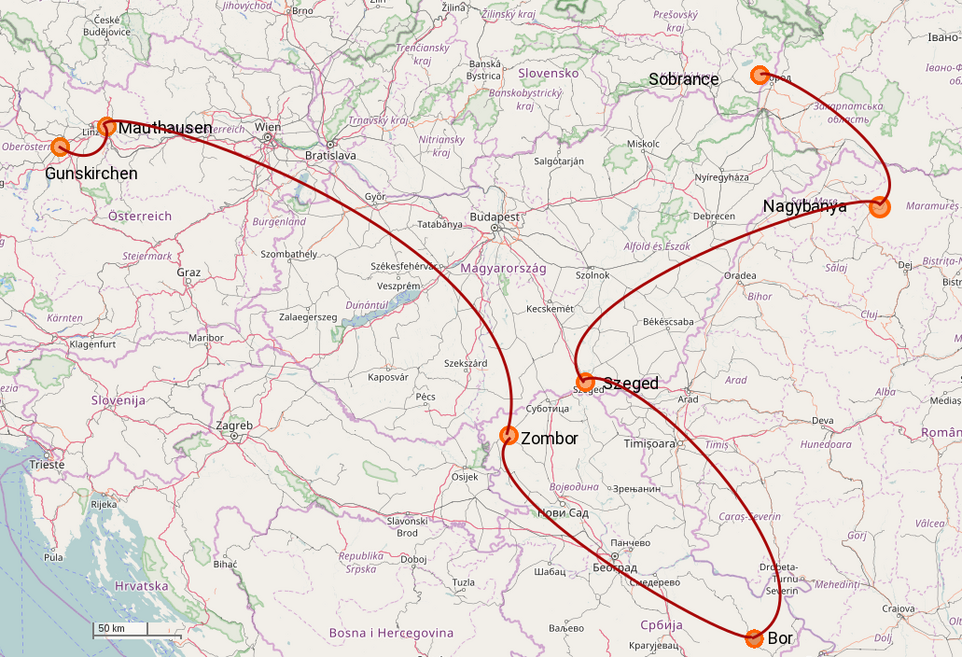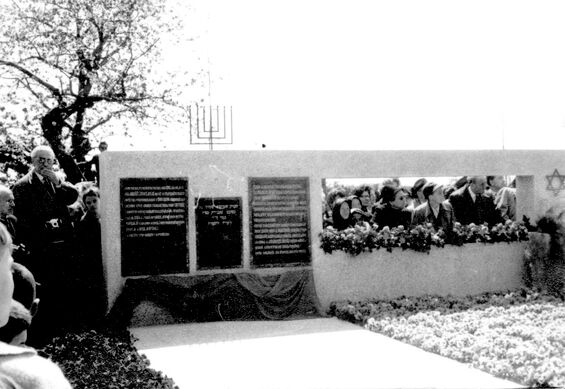The Biography of Salomon Reich, Sobrance
Short biography and stations of his persecution
- born on 1 October 1921 in Sobrance/CSR
- October 1942 Forced labour in road construction in Nagybanya/Romania
- January 1943 Szegedin: forced labour in road and railway construction
- May 1943 Forced labour camp Bor/Yugoslavia: work as a blaster in the copper mines
- September 1944 March to Mauthausen. Arrival at Mauthausen concentration camp in October 1944, mass murder of prisoners near Cervanka/Zombor en rout
- October 1944 to December 1944 Mauthausen concentration camp
- December 1944 March to Gunskirchen subcamp
- Liberation on 4/5 May 1945
- Sobrance, Vienna DP Rotschild Hospital, Hallstein
- 1951 USA
Salomon Reich was 21 years old when his persecution began.
Source: affidavit dated 16 April 1964
Before the persecution
I, Salomon Reich, born on 1 October 1921 in Sobrance/CSR, .... was living in Sobrance/CSR when the war broke out. My father, Hermann Reich, had a watch shop there and was a very well-off businessman. I myself was a perfectly healthy and cheerful person.
Source: unless otherwise stated: Konrad Kittl files, sworn statement by Salomon Reich dated 16 April 1964
October 1942 to May 1943 forced labour in Romania and Hungary
In October 1942, I was deported by the Germans to Nagybanya in Romania for forced labour. There I worked in road construction under heavy guard and was deported to Szeged in January 1943. My deportation consisted of being crammed into a cattle wagon and transported to another place with a lot of people. In Szegedin I wore the Jewish star and worked in railway construction, i.e. dragging tracks etc. and also in road construction.
I was beaten a lot and suffered from severe hunger. As a punishment, I was 'untied' several times, i.e. I stood on a chair, for example, my hands were tied to the wall with sticks and then the chair was pulled out from under me so that I was hanging in the air and I was beaten until I was unconscious. Then I was doused with cold water until I regained consciousness. After such treatment I started to crawl. I complained of stomach pains and headaches, but I had to go back to work because otherwise I would have faced the death penalty.
May 1943 to October 1944 Forced labour in the copper mines
In May 1943 I came to Bor, Yugoslavia, and I had to work there as a blaster in a copper mine. Once at work, when we had to change jobs, two of us were carrying the big drill, one of us with the rubber handles at one end and the other with the end of the drill. The drill fell out of one person's hand, the drill hit the ground, but as it had rubber grips, it jumped up again and I had the end in my hand, so the drill ripped open my cheek just under my eye. I couldn't open my eye for a few days and still had to carry on working. I was also beaten several times by the guards there and also 'tied up'. I also suffered from hunger, in the morning I was given black coloured water and some bread and in the evening the famous water soup. I worked 12 to 14 hours a day with inadequate clothing. In October 1944 I was deported to Mauthausen.
The march to Mauthausen
This time the deportation consisted of a death march. On the way to Mauthausen, I came to a place called Cervenka near Zombor. There were about 3000 of us and we were all billeted together in a brick factory. The whole factory was surrounded by the SS. Then they started shooting us one by one. They took small groups of us and positioned us next to a mass grave to gradually shoot about 1000 young people. I was also among the thousand, but before I was shot, I fell into the grave and after the shooting was over, I crawled out of the grave and rejoined the group.
Then we continued on the death march, where many of us were shot on the streets. We didn't get any food during the whole march. If the SS saw us picking up food from the street, they shot us for it. When we passed through Belgrade, people threw us bread from the windows. But if the SS saw one of us reaching for it, they immediately took the bread out of his hand and crushed it with their boots.
October 1944 to 4/5 May 1945
That's how I got to Mauthausen and I stayed there until December 1944, where I stood for hours on the roll call square and was beaten a lot. Then I went on to Ginskirchen (1) in a so-called death march. There, too, I suffered from hunger, was also beaten and stood in the roll call area.
Note (1): Gunskirchen
After the War
I was liberated in 1945 and returned to my home town to see if any of my family was still alive. Shortly afterwards I travelled to Bratislava, where I stayed until 1948. I received medical treatment there until I emigrated to Austria. In Vienna I was in the Rothschild hospital DP camp and received treatment there too. Then I went to Hallein and from there I emigrated to the USA in 1951 and since then I have been receiving constant medical treatment from Dr Lew; my state of health makes this urgently necessary.
New York, 16 April 1964
Notes
Further Sources
-----
Office for Compensation
---
Notes
---
Picture Credits
- Nagybanya, Transylvania, 1943-4, A Jewish labor battalion. Credit Yad Vashem Archival Signature 5657/1
- Bor, Yugoslavia, A forced labor camp. Credit: Yad Vashem Archival Signature 1249/51
- Bor, Yugoslavia, A work battalion in a stone quarry. Credit: Yad Vashem Album FA57/25
- Sombor, Yugoslavia, monument to the 680 Jews murdered in Bor. Credit: Yad Vashem Archival Signature 3016/17




